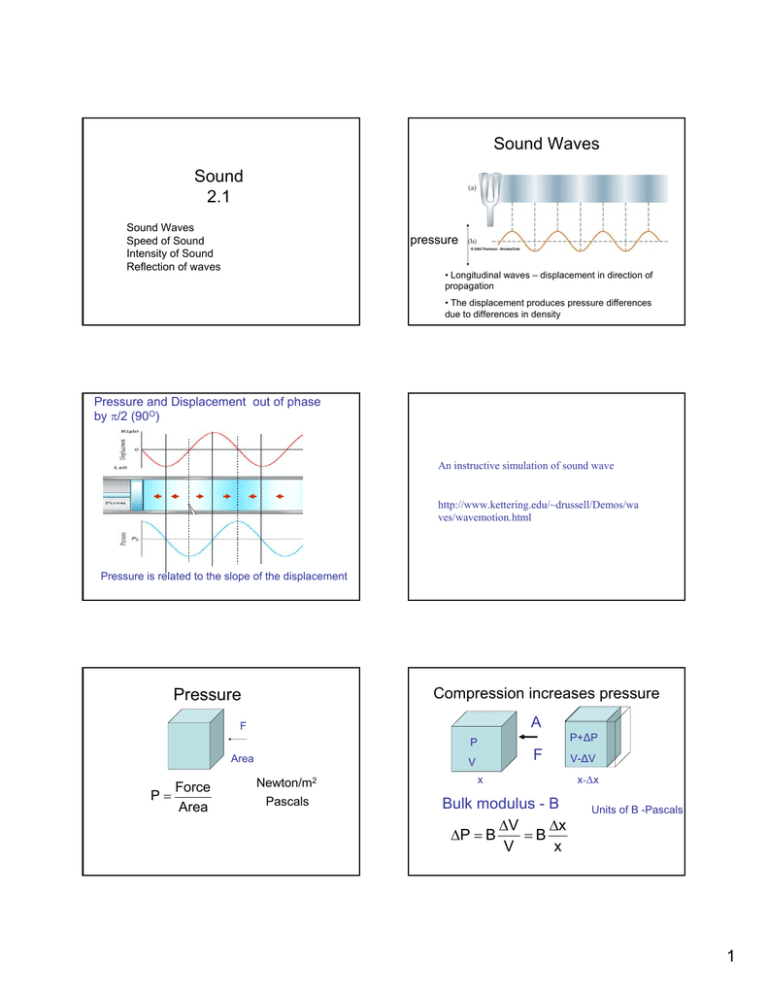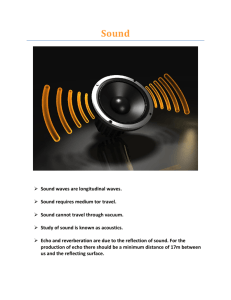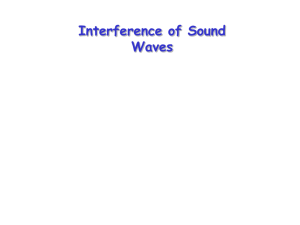Sound Waves Sound 2.1
advertisement

Sound Waves Sound 2.1 Sound Waves Speed of Sound Intensity of Sound Reflection of waves pressure • Longitudinal waves – displacement in direction of propagation • The displacement produces pressure differences due to differences in density Pressure and Displacement out of phase by π/2 (90O) An instructive simulation of sound wave http://www.kettering.edu/~drussell/Demos/wa ves/wavemotion.html Pressure is related to the slope of the displacement Compression increases pressure Pressure A F P+∆P P Area P= Force Area F V Newton/m2 Pascals x Bulk modulus - B ∆V ∆x ∆P = B =B V x V-∆V x-∆x Units of B -Pascals 1 speed of sound F compresses gas and changes speed. P P+∆P P P v P+∆P P v v v-∆v v F Pulse moves to right In frame moving with the pulse medium flows to the left ( in and out of the high pressure region) mass segment moves from low P to high P. V-∆V F = ma F = ∆PA ν = ∆P ρ∆ν ν2 = ∆PV σ∆V V ⎛ ∆ν ⎞ = ma = ρ Aν∆t ⎜ ⎟ ⎝ ∆t ⎠ ∆ ν ∆ V but = V ν = B σ Speed of sound in a gas v= B ρ ∆V ∆P = B V for a solid and liquid B is the bulk modulus Speed of sound in a gas v= monatomic gas –He diatomic gas O2 , N2 triatomic CO2 γP ρ 5/3 7/5 4/3 The bulk modulus for slow compression of a gas is equal to P. However, a sound wave compresses the gas quickly so that there is a temperature rise. (Adiabatic compression). For this case the bulk modulus is slightly larger by a factor of γ which varies according to the nature of the gas. Speed of sound in air • Air is a mixture of mostly diatomic gases. 80% N2, and 20% O2 ρair,20C = 1.20kg / m3 Pair, 20C = 1.01x105 Pascals v= 7x(1.01x105 ) = 343m / s 5(1.20) 2 Speed of sound in water Donald Duck Talk ρ water = 1000kg / m3 f= B water = 2x109 Pa v = 1500m / s Speed of sound in water is about 5 times that in air. the higher bulk modulus compensates for the higher density Demonstrates the speed of sound in He is faster than in air. The wavelength of speech is governed by the length of the vocal cavity. He = 4 gm/mole (monatomic) Air ~ 30 gm/mole (diatomic) V sound, He ~3 vsound, air Intensity of sound average power is the energy in one wavelength / period ↑ s Pav = E(λ ) T For a harmonic oscillator the average KE is equal to the average PE so the total energy is 2xKE =mv2 s = so cos(kx − ωt) dm = ρAdx v 2 = ω2so2 sin2 (kx − ωt) Problem The threshold of hearing is a sound intensity of about 1x10-12 W/m2. What is the maximum displacement of a sound wave in air at a frequency of 1000 Hz at this intensity? (ρair =1.2 kg/m2, speed of sound =340 m/s) v λ Pav = ∫ λ 0 dmv 2 T λ = ρAω2so 2 ∫ sin2 (kx − ωt)dx 0 T = ρAω2so 2 λ 2T divide by A to get intensity Iav = 1 2 2 ρω s o v 2 also Iav = ∆Po 2 2ρv see text. Two expression for the intensity Sound Intensity and Hearing • The human ear can perceive changes in sound intensity over a wide range of intensities. (12 orders of magnitude) • The perception of sound is not linear but logarithmic. • The decibel scale is a logarithmic scale of intensities that is useful for characterizing sound. 3 Hearing Decibel The unit of decibels β is a logarithmic description of sound intensity. β = 10log I Io Io = 10 −12 w / m2 • β is dimensionless, and increases as the log of the intensity • Io is the threshold for hearing. Question The ear perceives changes in loudness by a factor of 2 for a 10 dB change in intensity. What is the intensity that is 4 times louder than an intensity of 10-8 w/m2 a) 10-7 w/m2 b) 10-6 w/m2 c) 10-5 w/m2 d) 10-4 w/m2 Hearing covers a wide dynamic range of intensities. The maximum sensitivity is around 3 kHz. low frequency vibrations require higher intensities. Reflection of waves Waves are reflected at a boundary The wave cannot propagate across the boundary. fixed end inversion Partial Reflection at the boundary free end no inversion Reflection • Reflections are important to understand properties of waves in different media, i.e. partial reflection of light by glass. • Standing waves that are the basis for musical instruments are formed by wave reflection 4





